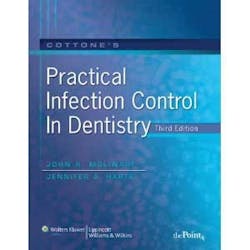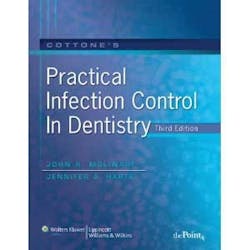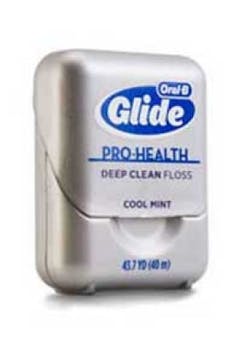Dental floss grabs much attention among devices used to access and remove interdental plaque
By Angela Morris, RDH, MS, CCRA, CCRP, and Christine Charles, RDH, BSDH
Inadequate removal of pathogenic interproximal dental plaque may progress to gingivitis and approximal caries.(1,2) Since more than 50% of adults have gingivitis, and the interdental areas may be more susceptible to periodontal disease, it is essential for patients to adequately remove interproximal dental plaque to promote oral health.(2,3,4) Various devices are designed to access and remove interdental plaque, and dental floss receives the most attention of all the interproximal devices.(2,5)
Inadequate removal of pathogenic interproximal dental plaque may progress to gingivitis and approximal caries.(1,2) Since more than 50% of adults have gingivitis, and the interdental areas may be more susceptible to periodontal disease, it is essential for patients to adequately remove interproximal dental plaque to promote oral health.(2,3,4) Various devices are designed to access and remove interdental plaque, and dental floss receives the most attention of all the interproximal devices.(2,5)
Dental floss is intended to remove plaque and food debris from interproximal areas that a toothbrush may not be able to access. The ADA has reported that floss removes up to 80% of plaque from interdental areas and recommends to incorporate floss as part of a daily oral care routine(6,7) as does CDA, ADHA and CDHA. When the proper technique is utilized, floss has demonstrated clinical efficacy with removing interdental plaque and reducing gingivitis.(3,8) However, in-home studies reveal that only 2% to 10% of patients regularlypoint perform acceptable flossing and that most cannot or will not floss on a daily basis.(9) According to Warren et al, there is conflicting data regarding floss efficacy as some studies support significant plaque removal from flossing whereas other studies have demonstrated an unclear benefit of flossing as compared to toothbrushing alone.(2) In 2008, a systematic review conducted by Berchier et al regarding plaque removal and gingivitis reduction of dental floss concluded that there is insufficient data to support routine flossing as a beneficial adjunct for reducing gingivitis and that flossing does not provide a plaque removal and gingivitis reduction benefit beyond brushing alone.(10) Similarly, a review conducted on the benefits of flossing on interproximal caries demonstrated that the data on flossing and interproximal caries reduction is difficult to interpret due to inconsistency across study results and that there have been no studies assessing real-world conditions and the benefits on interproximal caries reductions in an adult population.(11) However, the authors of both reviews encourage dental professionals to assess the benefits of “professional-quality flossing” based on a patient’s needs and capabilities.(10,11)
There are a variety of floss choices available and the composition of traditional string floss is typically classified as multifilament or monofilament as well as waxed and unwaxed. Multifilament floss is comprised of multiple strands whereas monofilament floss consists of a single strand. Examples of multifilament floss include, but are not limited to: REACH Mint Waxed, REACH GENTLE Gum Care, REACH CLEANBURST and REACH CLEANPASTE. Monofilament flosses slide easily and do not easily break.(12) Examples of monofilament flosses include, but are not limited to: REACH TOTAL CARE, Glide Original, Glide Deep Clean, Oral-B SATINfloss and REACH EASY SLIDE. Most recently Morris et al demonstrated superior plaque removal efficacy of the monofilament floss, REACH TOTAL CARE, in comparison to the monofilament Glide floss products.(13,14) Review of the literature shows several clinical studies with data supporting that it is not the material (i.e., monofilament vs. multifilament) or nature (waxed vs. unwaxed) of floss that determines efficacy but rather the mechanical action of removing plaque.(1,8,15) These study results demonstrate plaque removal and gingivitis reduction of different types of flosses compared to baseline but there were no statistically significant differences between floss types within a 2-8 week period, depending on the study.(1,8,15)
As dental hygienists, we strive to incorporate an evidence-based approach, including providing evidence-based oral homecare recommendations. The inconsistencies among the floss data introduce a challenge when recommending flossing as part of a patient’s daily routine; however, reviewing the literature and scientific data available on floss will help you decide if floss is the “right” fit for your patient because a patient with adequate manual dexterity, motivation and a quality flossing technique may benefit from flossing daily. In summary, although proper daily use of floss has been shown to have oral health benefits, under real life conditions the evidence is not solid. When taking into account each patient’s capabilities and motivation, you must decide for yourself the best tools for interproximal hygiene, whether it be floss for which a summary review has been provided or other tools such as interdental brushes, toothpicks, and/or rinses, based on scientific evidence and patient needs.References
1. Graves RC, Disney JA, Stamm JW. Comparative effectiveness of flossing and brushing in reducing interproximal bleeding. J Periodontol. 1989; 60(3): 243-247.2. Warren PR, Chater BV. An overview of established interdental cleaning methods. The Journal of Clinical Dentistry. 1996; II(3):65-69.3. Finkelstein P, Grossman E. The effectiveness of dental floss in reducing gingival inflammation. J Dent Res. 1979; 58(3):1034-1039.4. Oliver RC, Brown LJ, Löe H. Periodontal diseases in the United States population. J Periodontol. 1998;69:269-278.5. Bauroth K, Charles CH, Mankodi SM, Simmons K, Zhao Q, Kumar LD. The efficacy of an antiseptic mouthrinse vs. dental floss in controlling interproximal gingivitis: A comparative study. JADA. 2003; 134:359-365.6. Council on dental Therapeutics, American Dental Association. Accepted Dental Therapeutics, 40th ed., Section III, 1984.7. American Dental Association. Floss and Other Interdental Cleaners. www.ada.org/1318.aspx.Accessed March 2011.8. Lobene RR, Soparkar PM, Newman MB. Use of dental floss effect on plaque and gingivitis. Clinical Preventive Dentistry. 1982; 4(1):5-8. 9. Bader HI. Floss or die: implications for dental professionals. Dent Today. 1998;17:76-82.10. Berchier CE, Slot DE, Haps S, Van der Weigjden GA. The efficacy of dental floss in addition to a toothbrush on plaque and parameters of gingival inflammation: a systematic review. International Journal of Dental Hygiene, 2008; 6:265-279.11. Hujoel PP, Cruz JC, Bantin DW, Loesche WJ. Dental flossing and interproximal caries: a systematic review. J Dent Res; 2006. 85(4):298-305.12. Colgate Oral and Dental Health Resource Center. How to Floss. www.colgate.com/app/CP/US/EN/OC/Information/Articles/Oral-and-Dental-Health-Basics/Oral-Hygiene/Brushing-and-Flossing/article/How-to-Floss.cvsp. Accessed March 2011.13. Morris A, Santos S, Sinatra K, Cronin M, Goyal CR, Sharma N, Dembling W, Qaqish K, Qaqish J, Perfekt R, Wu MM, Demissie S, McGuire JA, Gell C, Queiroz D, Coelho J. Plaque removal of a revolutionary monofilament floss with flexible MICRO-GROOVES (ABSTRACT #1574). IADR/AADR 87th General Session and Exhibition, April 1-4, 2009.14. Morris AD, Santos SL, Cronin MJ, Goyal CR, Sharma NC, McGuire JA. Comparative plaque removal evaluation of two floss technologies (ABSTRACT). The Journal of Dental Hygiene; 2009. 83(4):206.15. Ciancio SG, Shibly O, Farber GA. Clinical evaluation of the effect of two types of dental floss on plaque and gingival health. Clinical Preventive Dentistry; 1992. 14(3):14-18.
1. Graves RC, Disney JA, Stamm JW. Comparative effectiveness of flossing and brushing in reducing interproximal bleeding. J Periodontol. 1989; 60(3): 243-247.2. Warren PR, Chater BV. An overview of established interdental cleaning methods. The Journal of Clinical Dentistry. 1996; II(3):65-69.3. Finkelstein P, Grossman E. The effectiveness of dental floss in reducing gingival inflammation. J Dent Res. 1979; 58(3):1034-1039.4. Oliver RC, Brown LJ, Löe H. Periodontal diseases in the United States population. J Periodontol. 1998;69:269-278.5. Bauroth K, Charles CH, Mankodi SM, Simmons K, Zhao Q, Kumar LD. The efficacy of an antiseptic mouthrinse vs. dental floss in controlling interproximal gingivitis: A comparative study. JADA. 2003; 134:359-365.6. Council on dental Therapeutics, American Dental Association. Accepted Dental Therapeutics, 40th ed., Section III, 1984.7. American Dental Association. Floss and Other Interdental Cleaners. www.ada.org/1318.aspx.Accessed March 2011.8. Lobene RR, Soparkar PM, Newman MB. Use of dental floss effect on plaque and gingivitis. Clinical Preventive Dentistry. 1982; 4(1):5-8. 9. Bader HI. Floss or die: implications for dental professionals. Dent Today. 1998;17:76-82.10. Berchier CE, Slot DE, Haps S, Van der Weigjden GA. The efficacy of dental floss in addition to a toothbrush on plaque and parameters of gingival inflammation: a systematic review. International Journal of Dental Hygiene, 2008; 6:265-279.11. Hujoel PP, Cruz JC, Bantin DW, Loesche WJ. Dental flossing and interproximal caries: a systematic review. J Dent Res; 2006. 85(4):298-305.12. Colgate Oral and Dental Health Resource Center. How to Floss. www.colgate.com/app/CP/US/EN/OC/Information/Articles/Oral-and-Dental-Health-Basics/Oral-Hygiene/Brushing-and-Flossing/article/How-to-Floss.cvsp. Accessed March 2011.13. Morris A, Santos S, Sinatra K, Cronin M, Goyal CR, Sharma N, Dembling W, Qaqish K, Qaqish J, Perfekt R, Wu MM, Demissie S, McGuire JA, Gell C, Queiroz D, Coelho J. Plaque removal of a revolutionary monofilament floss with flexible MICRO-GROOVES (ABSTRACT #1574). IADR/AADR 87th General Session and Exhibition, April 1-4, 2009.14. Morris AD, Santos SL, Cronin MJ, Goyal CR, Sharma NC, McGuire JA. Comparative plaque removal evaluation of two floss technologies (ABSTRACT). The Journal of Dental Hygiene; 2009. 83(4):206.15. Ciancio SG, Shibly O, Farber GA. Clinical evaluation of the effect of two types of dental floss on plaque and gingival health. Clinical Preventive Dentistry; 1992. 14(3):14-18.
Angela Morris (left), RDH, MS, CCRA, CCRP, is Senior Clinical Research Associate, Oral Care RD&E, Johnson & Johnson Consumer & Personal Products Worldwide, a Division of Johnson & Johnson Consumer Companies, Inc. Christine Charles (right), RDH, BSDH, is Associate Director, Scientific & Professional Affairs, Johnson & Johnson Consumer & Personal Healthcare Products Worldwide, a Division of Johnson & Johnson Consumer Companies RD&E Oral Healthcare.




